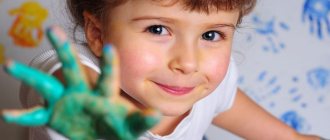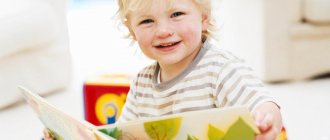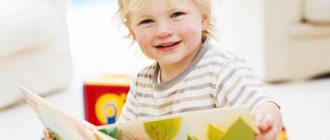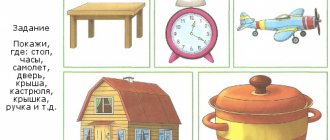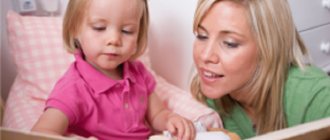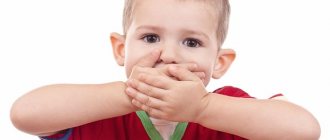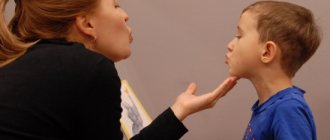When a child turns 3 years old, both parents and the baby themselves face tremendous changes. This is the famous crisis of three years, and a possible acquaintance with kindergarten, and for the first time truly meaningful behavior.
The pace of development of children is individual. Some three-year-olds already speak fluently, show interest in learning and strive for complete independence. Other children at the same age do not develop as actively, but this is not a deviation at all. However, there are general standards for what a 3-year-old child should be able to do. And if you are worried about whether your baby is developing in a timely manner, follow these standards and, most likely, you will make sure that everything is fine with your child!
Content:
- Basic skills of a child at 3 years old
- Physical development: main indicators Height and weight
- Physical skills
- Motor skills
Logical thinking
At 3 years old, children already have some logical thinking skills. They must be able to:
- combine two objects into a logical pair (“pencil-paper”, “tea-cup”);
- exclude unnecessary items from a group;
- understand the logical sequence of events (clouds gathered in the sky - it began to rain - the ground became wet);
- highlight the main properties of objects and combine them into groups according to these properties;
- understand time sequence (“yesterday”, “today”, “tomorrow”, “now”, “later”);
- distinguish opposites (big - small);
- understand the location of objects in space (“above”, “below”, “above”, “below”).
Basic skills of a child at 3 years old
What a child should be able to do at the age of three - basic standards:
- understand simple cause-and-effect relationships, for example, “fell in a puddle - got dirty”;
- begin to strive for independence: try to dress yourself or with minimal help from an adult;
- actively expand your vocabulary, use complex sentences in speech, for example: “We didn’t go for a walk because it was raining outside”;
- know the basic colors and the words that these colors represent;
- recognize obstacles in the area - for example, steps, curbs - and overcome them;
- be able to show emotions and control emotions, show empathy;
- understand the meaning of the words “mine” or “his/her”
- play role-playing games - for example, “teacher-student”, “doctor-patient”.
Game No. 1 “Learning to count” (for kids 3-4 years old)
DESCRIPTION: An educational positive game that will make counting fun and interesting. With such a game you can play with your child at any free moment. You can print these pictures in advance and play at any time!
Attention! How to copy coloring pictures from our website?
- Choose any picture. Right-click on the picture.
- Select "Save Image As". Save it in a convenient folder and print it from there!
Physical development: main indicators
The physical development of a child is assessed according to three main criteria: height and weight, physical abilities, and motor skills.
Height and weight
The height and weight of two children at the age of three can differ significantly - these physical parameters depend on hereditary factors and, to a lesser extent, on the child's gender and lifestyle. In pediatrics, the “golden mean” for the weight of a three-year-old is considered to be 15 kilograms, for height - 95 centimeters .
If your baby’s height is 10% less than the standard 95 centimeters, this is not a cause for concern, but, most likely, a personal developmental feature. But if your son or daughter’s height at 3 years is less than 85 centimeters, you should think about eliminating negative factors: try to adjust the baby’s diet and organize reasonable physical activity for the child, after consulting with a doctor.
In the weight parameters for a three-year-old child, deviations of 20% are allowed in both directions from 15 kilograms. If the baby’s weight is less than 12 or more than 18 kilograms, you may need to reconsider the diet, taking into account the recommendations of pediatricians.
Physical skills
Basic physical skills of a three-year-old:
- knows the terrain well enough, remembers familiar routes;
- draws and makes simple appliqués himself;
- knows how to ride a tricycle:
- claps his hands and stomps his feet well;
- With the help of his parents, he assembles quite complex construction sets, and also puts together multi-part puzzles with outside help.
Motor skills
By the age of three, the child’s motor activity develops noticeably even compared to the period of several months preceding the third birthday. Basic motor skills of a child at three years old:
- maintains balance while standing on one leg;
- climbs and descends stairs without assistance;
- plays various ball games;
- runs, rarely stumbling and falling;
- repeats simple dance movements: jumps, rises on tiptoes.
Nuances of the psyche of three-year-old children
The developmental characteristics of 3.5-year-old children indicate big changes in their emotions. Children develop a sense of self-esteem, they are proud of themselves that they can do something better than anyone (jump, play), that they have the best parents: the smartest dad, the kindest mother. They develop an understanding of humor; cartoons or comical life situations make them laugh. Kids notice beauty and ugliness in nature and in life and can appreciate it.
A child can react emotionally in different situations:
- empathy if someone nearby is feeling bad or in pain;
- help, if he can do it;
- responsiveness: if the parents are tired, he will not interfere with their rest;
- sympathy for the heroes of fairy tales and cartoons: he can be happy, sad, angry with them;
- understanding that he acted badly makes him sad and ashamed;
- experience in anticipation of a negative assessment or censure from adults.
A child can harbor a grudge for a long time if he is punished. But he sees when someone else acts badly and evaluates such an act negatively: you can’t do that. Sometimes you may encounter exaggerated feelings of jealousy or resentment. And there is no need to teach him pretense and cunning, pranks and pranks. A sense of caution is being formed, a distinction is made between the concepts of danger - safety, harm - benefit, anxiety and fear of the dark may often appear. A three-year-old child can complete verbal three- or four-step instruction. The child’s compliance increases, he begins to realize the possibility of delaying the immediate fulfillment of his desires. With the right parenting, three-year-olds can hold back emotionally.
Development of fine motor skills
The fine motor skills of a three-year-old are becoming more and more perfect. The child develops previous skills and acquires new ones:
- enjoys repeating finger gymnastics exercises;
- reinforces speech with gestures, and if the baby is emotional, gestures can be very active;
- builds buildings of different sizes and configurations from cubes;
- learns to use scissors and can cut out simple shapes from paper;
- knows how to sculpt simple structures from plasticine: flagella, balls;
- confidently grasps and holds objects;
- opens loose caps on bottles.
Game No. 2 Where is this letter hidden?!
- Draw or find the beautiful letters you have learned. Print each letter in duplicate
- Select a game letter. Let's assume this is the letter "F"
- Keep one letter for yourself
- Hide the second copy of the letter and invite the child to find it
- Hide the remaining letters in accessible places as well.
- Show your child a letter, name it and ask him to find it
- Tell me if your child is confused and needs help.
- Remember! The child should be happy while playing and should not be upset that he cannot find the letter. If he starts to worry, then this method will become uninteresting for him.
Development of hearing, vision, touch, taste
The hearing of three-year-old children requires especially careful attention. At this age, children often catch colds, which can lead to otitis media and, as a consequence, hearing impairment.
In order not to harm your child’s hearing, be sure to teach him to breathe through his nose and not his mouth, treat a runny nose in a timely manner and try to avoid sudden changes in temperature.
The vision of three-year-old children is not yet sharp enough compared to children of older preschool age. Vision is fully formed only by 6-7 years. You should not try to teach your child to read as early as possible - children's vision is ready for reading only at the age of five . Of course, you can show books to a three-year-old, but the books must use large font. To preserve fragile children's vision, reduce your child's contact with the phone, computer, and TV.
At 3 years old, children’s sense of touch is well developed: they distinguish between cold and hot water, warm and cold wind, rough and smooth surfaces. The taste buds of a three-year-old child are developed in the same way as those of an adult. It distinguishes between sweet, bitter, sour and salty tastes, preferring sweets.
Norms of speech development
A three-year-old child already has a fairly rich vocabulary: at least 1000 words. The clarity of speech at this age is not yet impeccable: the baby may distort words and have difficulty pronouncing individual sounds correctly. A three-year-old is already able to reason in a simple form about an object or event he saw.
A 3-year-old child does not speak or speaks little: what to do?
At three years old, a child’s speech skills are sufficiently developed to be able to communicate with other people. Normally, by the age of three years, a child has the following speech skills:
- understands the questions asked and answers them;
- knows his first and last name well;
- speech becomes coherent, resembling a story: one sentence follows from another;
- describes the picture he saw, paying attention to details;
- retells short tales and stories.
Children who speak almost or not at all by the age of three are quite common. The famous Russian pediatrician Evgeniy Komarovsky advises parents whose children at 3 years of age do not yet speak to pay attention to the type of stubborn silence: is the child silent because he does not understand the speech of those around him, or does the baby understand everything, but says nothing?
If a child shows signs of understanding without using words, perhaps silence is his personal trait. Three-year-old silent children, according to pediatrician statistics, are more common among boys—for every one non-talking girl, there are four such boys. According to the same statistics, at least 7% of children aged three years do not speak at all.
In any case, if a three-year-old child does not speak at all, you need to visit a pediatrician with him. Based on the examination results, the doctor will recommend ways to solve the problem or refer you to specialized specialists.
Behavior of children of different temperaments
Adults notice that children of the same age can react differently to the same words from their parents. Some will start crying, some will listen calmly, and some will throw a huge tantrum. In fact, each child needs an individual approach, because all people (even the smallest) are different, with their own temperament and character. If you find an approach to a child based on his temperament, you can cope with even the most capricious and problematic children.
If the same approach in education is applied to all children, this is fraught with serious psychological problems in the future. The child will behave inappropriately, show aggression, and personality degradation may occur in the future. The method of our grandparents, when all children could be whipped with a belt and put in a corner, does not work.
Authoritarian, despotic parents do not even try to hear their child, but practically remake him for themselves, breaking his fragile psyche. A person who was abused, humiliated, or beaten by his parents as a child is likely to be addicted to alcohol, nicotine, or illicit drugs. It is difficult for such people to find a common language with others; their personal lives often do not work out.
By the age of 3-4 years, the baby is already beginning to develop his own temperament. Psychologists separate the concepts of “temperament” and “character”. Temperament is a type of behavior that is inherent in a person from birth by nature, and character is formed through upbringing.
There are four types of temperament:
- melancholic;
- sanguine people;
- choleric people;
- phlegmatic.
Temperaments are practically never found in their pure form. Usually in a person there is a mixture of several types, for example, 80% choleric and 20% sanguine. Babies with different types of prevailing temperament react differently to the same situation. The differences are especially noticeable in cases where children do not get what they want.
Melancholic people
Such children require special attention to their person. They react sharply to any comments, and raising their voice at them is tantamount to physical punishment. Melancholic people are very sensitive, they are easily offended and hurt. Under no circumstances should such children be shamed in front of strangers. For melancholic people, even just being among a large number of children and adults is a serious test. That is why adaptation to kindergarten is difficult and painful for them. There is no need to demand any outstanding results; it is enough that the baby is surrounded by strangers.
Sanguines
As a rule, children with a dominant sanguine temperament do not cause parents any special problems. They are almost always in a good mood, without mood swings. If a child is upset about something, he will not throw tantrums and lie on the floor. He interacts well with other children in a group, loves active games, and has no problems sleeping, which has a beneficial effect on the state of the nervous system.
One of the disadvantages of sanguine children is that they are quite cunning. If the baby does not want to do what is asked of him, he will not do it. The main mistake parents make is that they take their child’s word for it and follow his lead. If you ignore this nuance, the baby will grow up to be a deceiver. Parents should raise a sanguine person calmly, without shouting or reproaches, but the child must fulfill their wishes and demands. Also, you should not over-praise the baby, otherwise he may catch the “star” disease. You need to praise for actions and actions, and not just like that.
Very interesting: Is it possible to deceive children: the opinion of psychologists
Cholerics
Always active, running somewhere, grasping at any task, but also quickly giving up. They are highly emotional and often have problems falling asleep. It is very important to raise a choleric child correctly, otherwise he may grow up to be an unbalanced, angry person. The main mistakes of parents:
- aggressive attitude;
- overprotection.
When a little choleric person gets angry and starts playing pranks and destroying the whole house, you need to try to remain calm and not raise your voice. You shouldn’t put pressure, force, or impose your opinion. It is advisable to agree on some things in advance and discuss prohibitions.
Phlegmatic people
Children are not only active and noisy, but also calm and balanced. Phlegmatic people are slow, thoughtful, and love to sleep for a long time and laze in bed. Phlegmatic children perceive information well if it is presented by example. Parents need to be actively involved in raising a phlegmatic child, otherwise he will remain inert.
Parents need to be sensitive and attentive when raising their children.
They must be able to distinguish the reasons why the baby does not listen, and take action in time. Every day, mom and dad build trusting and warm relationships with their children, although sometimes this is difficult. If you take into account the baby’s temperament, educational moments and communication will be much easier for all family members. leave a comment
Communication skills and emotional sphere
A three-year-old child needs to communicate with peers more than before. The child is already learning to manage emotions and trying to resolve conflicts peacefully. At the same time, the three-year-old feels an urgent need to express his “I”, which leads to capricious behavior towards parents and other close people. Closer to four years, the child begins to understand other people's emotions, learns to control himself and excessive whims disappear.
The emotional sphere of three-year-old children is actively developing: they begin to fantasize. The guys with the richest imagination even surprise others with stories of their own creation. Normally, an emotionally developed child at 3 years old strives to repeat the actions he likes after other people, and knows how to express likes and dislikes.
Mental development
Along with the crisis of three years comes the age of “why”. The child asks adults about everything in the world, compares the answers, and draws conclusions.
The pace of mental development in different children may differ depending on the child’s personal abilities and the involvement of adults in the development process. Intellectual development at the age of three is considered normal if the child can:
- distinguish 4-8 colors;
- examine the object not only as a whole, but also notice details;
- do not be distracted too often, concentrate on one activity;
- make simple plans, for example: “in the morning we will go to kindergarten, and in the evening you will take me home”;
- count to five;
- find answers to children's riddles;
- operate with the concepts of “more-less” and find other differences between objects;
- memorize simple poems and songs;
- distinguish basic geometric shapes from each other - circle, triangle, rectangle, square - and name them.
Cognitive development
Children's cognitive skills include the development of perception, attention, memory, and thinking. The speed of cognitive development is influenced by the child’s exploration of the world around him: the more the baby interacts with different objects and the more he observes different phenomena, the better his cognitive abilities develop.
It is important for three-year-old children to experience the world in practice, which is why it is so important to reinforce the child’s personal experience with explanations from an adult. For example, explain the difference between opposing concepts (“narrow path - wide road”), encourage the child’s desire to analyze situations and events, and focus on specific details of objects.
At the age of three years, a child, with the help of perception, forms an idea of the properties of objects. He learns to compare the sizes and shapes of objects, knows the purpose of different things and uses them correctly.
The baby's attention becomes stable: he focuses on an interesting activity for 10-20 minutes, does not let several objects out of his sight at the same time. But a three-year-old can still get distracted quite easily.
Memory at three years of age is involuntary: a child remembers information that is interesting to him, but it is not yet easy for a child to learn something specifically.
Although the child can already establish cause-and-effect relationships, his thinking is still limited to the present time. A three-year-old child evaluates the situation “here and now,” but as the child learns about the world, his ability to analyze gradually develops. At the age of 3, children especially clearly feel the joy of a discoverer, and the more events that happen around the young explorer, the better his thinking develops .
Games for developing memory and attention
We have selected the top 5 games that can be played everywhere! They do not require special items or toys. Play at home, on the street, in the store!
Game 1 “Magic Word”
Goals: development of attention; mastering the rules of etiquette.
Description: the child must listen carefully to what the adult said and fulfill the request only if the adult said the word “please.”
For example: an adult says “Jump!” - the child should not react to words.
If an adult said “Sit on the sofa, please,” “Bring a book, please,” then the child must sit down, bring a book, etc., fulfill the request, since the word “please” was said.
Game 2 “I’ll tell you, and you remember”
Goal: to develop memory, attention, observation.
Description: a very simple game that perfectly develops memory in children 3-4 years old. Invite your child to repeat the items you listed. Start with a small number of items. The first few times, group items by type - furniture, toys, fruits, vegetables. In the future, you can increase the number of objects, add objects from other semantic categories: sofa, table, chair, doll, cup, ball, etc.
Independence, self-care skills
Young children are not yet able to take care of themselves completely, but by the age of three, the child should already have some self-service skills:
- undress and dress with little assistance;
- put on shoes or at least try to put on shoes on your own;
- wash your face and brush your teeth;
- use cutlery;
- fulfill simple everyday requests: put away toys, put things in their place, put a cup on the table.
Everyday experience of three-year-olds
Parental and pedagogical practice has accumulated a large list of what a 3.5-year-old child should be able to do. The baby knows how to dress and put on shoes independently, easily copes with clothes without fasteners, and learns to fasten conveniently located buttons. He also undresses himself and before going to bed he can put his clothes on a high chair. The baby should already have hygiene skills:
- notice disorder in your appearance and clothing;
- be able to wipe your feet after a walk before entering the house;
- use a handkerchief or napkin;
- wash your hands using soap and dry them with a towel;
- insert the keys into the lock in the doors and turn them;
- use the toilet in a timely manner.
The child happily helps his parents clean the house, work on the property, and do shopping. The baby likes it when he is trusted to carry plates to the table and knows how to use a spoon and fork himself.
Daily routine and care for a three-year-old child
The baby becomes very active, and it is important to adhere to a daily routine so that the child has enough strength. Of course, the routine of a child who goes to kindergarten will differ from the routine of a child who does not attend preschool, but an approximate daily routine for three-year-olds could be like this:
| 07.00 | Climb |
| 07.30 | Hygiene procedures, exercise |
| 08.00 | Breakfast |
| 08.30 | Educational games and activities, help with everyday life |
| 10.00 | Walk |
| 12.00 | Dinner |
| 12.30 | Daytime nap |
| 15.00 | Awakening |
| 15.30 | Afternoon snack |
| 16.00 | Outdoor and educational games |
| 18.00 | Walk |
| 19.00 | Dinner |
| 19.30 | Quiet activities |
| 20.30 | Hygiene procedures |
| 21.00 | Night sleep |
⠀
Weekly exercise program
Exercises that will help your child develop all the necessary skills:
- Monday: thematic lesson “Trees and Shrubs”, the game “Guess what’s in the bag”, listening to birdsong and the sound of waves, memorizing a poem about summer, sorting through peas and beans, creating an application “Flower Garden”.
- Tuesday: learning about professions, toy bowling, repeating a poem about summer, memorizing the song “Antoshka”, reading the fairy tale “Kolobok”, mosaic “Letters and Counting”, drawing the sea and sky.
- Wednesday: learning letters and syllables using cubes, playing to guess sounds, repeating the song “Antoshka”, drawing a yard with a house and flowers, modeling dough.
- Thursday: playing with a construction set to study shapes, drawing with sand, learning the “Birch” dance, cutting out snowflakes and flowers from paper.
- Friday: thematic task “Numbers and Counting”, game “Where the Ball Hid”, repetition of “Birch Tree”, composing the fairy tale “Kolobok” using cards, game with lacing, sculpting an animal from plasticine.
- Saturday: thematic lesson “Animals in the Wild”, water games, listening to Vivaldi’s composition “Seasons, Winter” and discussing the emotions it evokes, drawing any animal, analysis of the saying “Time for business is time for fun.”
- Sunday: acquaintance with the inhabitants of the sea, applique from scrap materials, home concert for relatives with the performance of a poem about summer, the dance “Birch” and the song “Antoshka”, repetition of the studied letters, making a hedgehog from plasticine and matches, depicting your mood using paints.
The development of a 3.5-year-old child directly depends on the efforts of the parents, so it is important to find suitable games and activities that will help the child explore the world.
How to determine the developmental delay of a child at 3 years old?
Signs that may indicate problems with the baby's development:
- he is not interested in communication - neither with adults nor with other children;
- does not play with toys, does not show curiosity about unfamiliar objects;
- does not even recognize familiar objects;
- cannot even minimally control the expression of emotions;
- does not understand the speech of others.
If you notice similar signs in your child, contact your pediatrician.
Learning colors with kids 3-4 years old!
Game No. 1. Game “Where is this color found?”
Goal: remembering colors. Equipment: multi-colored sheets corresponding to the rainbow.
Progress of the game: Show your child the color and ask him to remember where he saw such a color in nature, life, or in his toys.
For example, Red - Little Red Riding Hood, tomato, red car. Orange – orange, shoes. Yellow is the sun. Green – grass, leaf. Blue - sky. Blue —blue felt-tip pen. Violet – violet flower.
Game No. 2. Game “Draw a rainbow and remember the colors”
Game No. 3. Sort the toys by color and get a smiley face
Give your child the task of sorting objects - toys, books, pictures, small objects by color. Praise him when he does everything and give him an appreciative smile. He's great!
Game No. 4. Color the flower by color - each petal has its own color.
How to help a child develop correctly?
It is possible and necessary to help a three-year-old child develop - despite the desire for independence, children at this age willingly accept help from adults. Especially if this help is presented in the form of a game.
How to help three-year-old children develop important skills and abilities in accordance with the recommendations of teachers:
- Ask your child to tell you in detail how his day went. This technique trains memory better than special educational games.
- Resist in offering help. The less outside help, the faster the three-year-old will learn independence.
- Use your fingers to learn to count within five, and a little later - up to ten.
- In toys, give preference to pyramids, cubes, puzzles - they perfectly develop the skills of attentiveness, perseverance and spatial thinking.
- If there are no health contraindications, introduce your son or daughter to sports. Swimming is especially suitable - a universal way to maintain health, form beautiful posture, and strengthen all muscle groups.
Do not worry about the development and safety of your child, especially when he is away from you or home. Three years and going to kindergarten is a great reason to buy your baby his first GPS watch. With them and the “Where are my children” application, you will always know where your child is and what is happening around him.
Games
Play is the most important activity for a three-year-old child. At this age, the child enjoys the process exclusively, without setting a goal to learn new things. But parents can offer their son or daughter games that will help children's development.
Examples of educational games for three years:
- Games with water. Kids love to be in contact with water - help your little ones create their own water world. You can include bowls, glasses, a colander, and a spray bottle in the game and show how to play with water using these items. Water games develop imagination, coordination, and fine motor skills.
- Finger games. Classes with elements of finger gymnastics, like no other, develop fine motor skills.
- Modeling from plasticine or salt dough. Modeling helps develop creativity and fine motor skills.
- Games with cubes of different shapes and sizes. While building with cubes, reaction speed develops, the baby remembers colors and shapes, learns to compare objects and masters counting.
- Puzzles and mosaics. Starting with simple options, move on to more complex ones with more details. Puzzles and mosaics develop the ability to concentrate, develop imagination and fine motor skills.
Another feature of this period of child development is the three-year crisis. It is not simple. But you need to survive it, showing patience and helping the baby develop. And when the difficulties are left behind, the child will become an excellent conversationalist, play partner and best friend for his parents!
Game No. 2 Learning to count “Color by numbers”
Children and parents love this game very much! All you need are funny pictures and pencils. Just color the pictures with the colors you want. Look how crazy it turns out. The child remembers numbers, develops fine motor skills, and studies animals in this game!
Find a complete collection of pictures for coloring for children 3,4,5 years old HERE.
Attention! How to copy coloring pictures from our website?
- Choose any picture. Right-click on the picture.
- Select "Save Image As". Save it in a convenient folder and print it from there!

